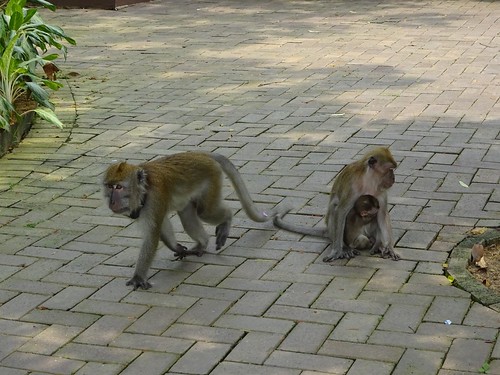Long-tailed macaques are a concern to primatologists because they are facing habitat loss, habitat fragmentation and are also subjected to population control measures by humans like culling (Quammen, 2011). The current measures in place are not enough as even with education and laws, the feeding of monkeys still occurs and culling does not solve the problem. No one method alone can solve the human-macaque conflict and a combination of strategies should be applied to address this issue more effectively.
Long-tailed macaques are one of the last remaining mammals that are native to Singapore and they aid in seed dispersal in forests, making them ecologically important(Sha et al., 2009a). Hence it is essential for us to learn to manage the human-macaque conflict in a sustainable manner.
Monkey Guards
This is a pilot programme by ACRES that involves herding monkeys away from homes. These monkey guards can also warn people if their interactions with macaques will provoke aggression. While the results are promising, more research and funding is needed to continue this effort (Khew, 2014).
Source. Animal Concerns Research and Education Society. (2015, October 26). Guard the troop leader, herd the family away! [Video File]. Retrieved from https://www.facebook.com/ACRESasia/videos/vb.22159071522/10153284910686523/?type=2&theater
Creating buffer zones
(Jones-Engel, Engel, Gumert & Fuentes, 2011)
Knowing that macaques have a preference for forest edges, the government can step in to create buffer zones.
- Restrict housing developments that encroach on forest edges
- Ensure that existing residences comply by certain building standards to discourage macaques from entering
Government authorities are usually called in to settle macaque complaints and they are the ones who play the most important role in enforcing laws and regulations to ensure that human behaviour at the human-macaque interfaces do not exacerbate the conflict.
Modifying landscapes and structures
(Jones-Engel, Engel, Gumert & Fuentes, 2011)
The government can step in to modify the landscapes in human-macaque interfaces to reduce conflict
- Speed bumps and signs to urge drivers to slow down at areas that macaques frequent
- Clear signage to educate the public about how to avoid conflict with macaques
- Make walkways and bridges large enough (2.5m wide) so that people can pass macaques with at least 1m distance
- Build enclosed carparks for residents
Research
Research on sterilisation, its effectiveness and its impact on macaques has to be done in order for us to understand if this is an appropriate alternative (Feng, 2015b). However, since the size of the population is not the main cause of the conflict, reducing it may not be effective in mitigating the human-macaque conflict.
Research can also be done on the barriers that prevent people from performing responsible behaviours (Gardner & Stern, 2002) to understand how we can encourage more positive human behaviour with regards to the human-macaque conflict.
NParks is currently keeping track of macaques via global positioning system (GPS) collars to better develop long-term strategies to address the human-macaque conflict (Feng, 2014). The data obtained helps us understand where the macaques tend to go and how long they spend at those areas. This may be able to aid in keeping monkeys away from homes more effectively, thereby reducing the need to cull them.
